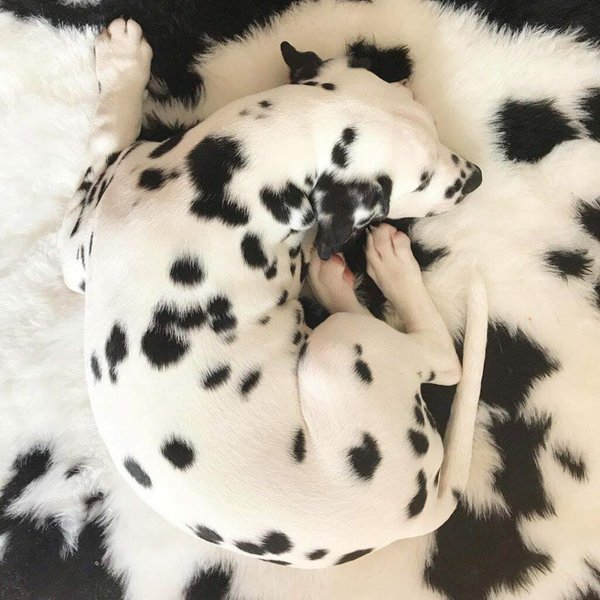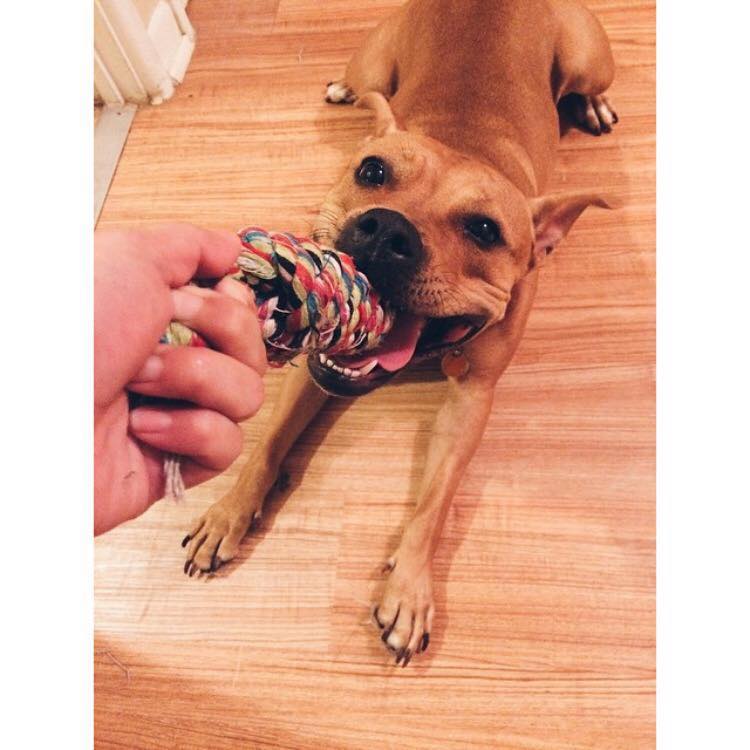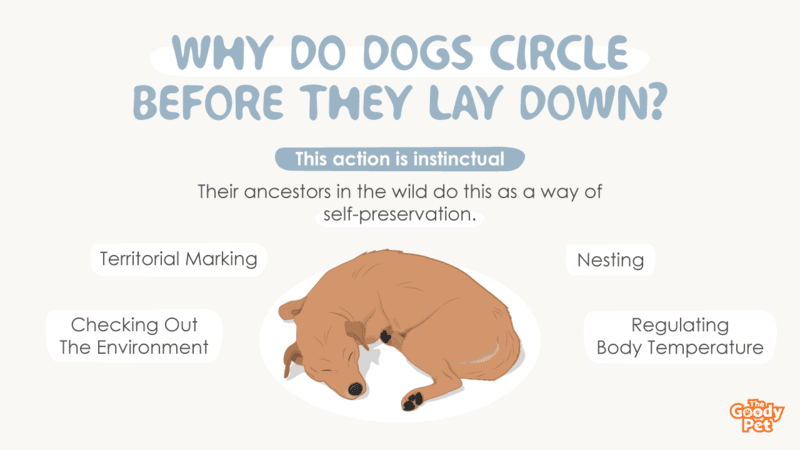How often do you see your dog getting ready to rest but before finally settling on its bed, it just keeps on circling until it finds its sweet spot? On some occasions, you may even see your dear Fido digging or scratching on the beddings or the carpet. The good news is, most of the time, you shouldn’t lose a good sleep over this circling canine behavior.
One major reason why dogs circle before they lay down is because this action is instinctual, or stamped on their DNA. They got this behavior from their ancestors in the wild that would turn around in circles as a way of self-preservation, thereby protecting themselves from possible intruders.
But, there are also instances when circling before lying down is brought about by a problem in their middle to inner ear areas called vestibular system health problems.
Today, we’d be talking more about these different reasons why you see your dog circling before settling in on its bed. Does hierarchy have something to do with this behavior? Should you get alarmed when it gets excessive? Let’s get into the details now…
Is It Normal For Dogs To Spin In Circles Before They Lay Down?

Yes, it is normal for dogs to spin in circles before finally finding their safest place to doze off.
The reasons could be any of the following: checking out the environment, nesting, body temperature, and owning their space.
Checking Out The Environment
As we mentioned a while ago, circling before lying down is an instinctive behavior. Wolves did this circling or spinning behavior to survive in the harsh realities of the wild.
In a nutshell, the ancestors of our fur babies would circle before lying down in order to determine the wind direction. This is very important because knowing the direction of the wind made it easier for them to locate exactly the scent of an impending attack by their enemies in the wild.
Through smell, wolves knew if they needed to run for cover to save themselves from nearby predators.
This self-preservation instinct is still very much intact even among our domesticated dogs. This behavior is more evident among those dogs that are more nervous and have a higher sense of protective instinct.
They would naturally circle themselves before lying down to make sure that it is already safe to call it a day.
You can call this behavior a protective instinct. To lessen behavior, what you can do is to place your dog in a crate where it would feel safer about its environment.
Doing so will reduce your dog’s circling behavior from which you can also benefit. Plus, admit it or not, circling behavior can sometimes be sleep disruptive to us humans.
Nesting
Another reason why dogs spin in circles before they lay down is simply that they want to find the most comfortable spot on their bed.
In the wild, their ancestors did the circling behavior to check for any stones or perhaps some twigs that would make their rest uncomfortable.
The same is true for our fur babies, they spin in circles, sometimes even gathering pillows and blankets to build a comfortable nest for them to sleep on.
To Regulate Their Body Temperature
Have you noticed that your dog tends to dig a little bit more during the summer months? It’s because that’s what their ancestors did in the wild – to dig the earth so as to expose the cooler underground soil.
That said, the circling behavior is your dog’s instinctive behavior to ‘remove the topsoil’ and to ‘sleep on the cooler ground’ during hot, summer days.
The same can be said during the cold months. Dogs circle around before they curl up into a tight ball so as to conserve their body heat.
This Spot Is Mine
We all know that dogs are social animals that belong to a hierarchical pack. This bedtime circling routine was part of the rituals of their ancestors in which it identified the wolf’s place in the hierarchy.
In the case of domesticated dogs, they circle before they lay down as a way of sending the message to the other members of the pack that ‘this is my space and I am claiming it.’
Circling allows dogs to leave some scent from their paws as a way of territorial marking.
And, even if our dear Fidos now sleep on comfy cushion dog beds, circling ‘flattens’ the spot thus, leaving a visible sign to others that this space has been taken. This is an instinctual behavior that is still very much ingrained in their systems.
Why Does My Dog Keep Circling? Should I Worry?
Yes, there are cases when excessive circling behavior is a manifestation of a medical problem.
Since dogs cannot pinpoint to their humans their pains, circling excessively before lying down could be their way of letting us know that something’s off with their bodies. They make several revolutions because of the difficulty of finding a pain-free and comfortable position.
Excessive circling could be a result of any of the following: a physical health issue, vestibular health problem, or cognitive disorder.
Physical Health Issue
Is it your first time to see your senior dog circling before resting? If yes, it could be a result of physical discomfort.
Health problems like back or joint pain as well as abdominal ache could be the reason why all of a sudden your older dog is circling excessively.
In this case, your dog is finding it very difficult to find a comfortable position to rest and sleep because it is in pain.
Vestibular Health Problem
This is a health problem affecting the peripheral or the central nervous system of older dogs. The vestibular system can be found in the inner ears and if afflicted, balance and coordination are compromised.
Aside from circling, the other symptoms of this sudden health issue are disorientation, head tilting, and irregular eye jerking referred to as nystagmus, the cause of which is a problem in the nervous system.
What are the various reasons that affect the vestibular system of dogs? The growth of yeast and bacteria is one of the reasons. This causes damage to their inner ear that eventually leads to circling behavior.
For you to understand better what a damaged vestibular system is, it is the one that can cause humans to feel nauseous, dizzy, and develop vertigo. In the case of our dogs, having trouble in the vestibular system can make them sick, vomit, and do spinning behaviors.
The good news is that most of the time, the issue of the mild geriatric vestibular problem would usually resolve on its own.
Still, we suggest that you have your dog treated, otherwise, the experience can be quite traumatic for some older dogs.
Cognitive Disorders
Senior dogs can develop cognitive disorders that cause them to behave differently, circling being one of those. One of these cognitive disorders is dog dementia, also referred to as Canine Cognitive Dysfunction.
In fact, dogs that are already in an advanced stage of dementia tend to circle excessively because of a spatial orientation problem.
In some cases, brain strokes or tumors are the culprits as to why dogs circle excessively. That said, we recommend that you have your senior dog examined by a vet to find out if there is an underlying condition why it circles excessively.
How Do I Stop My Dog From Spinning In Circles?
If you see your dear Fido spinning in circles, you may want to address this behavior before it’s too late. Sometimes, ignoring the behavior may only worsen over time and would become very difficult to stop.
Do your best to correct this behavior by following our tips below:
- The first step is to take your dog to the vet to rule out any health issues.
- When your dog begins circling, disrupt the behavior by offering a toy or shake a can filled with coins. The noise will divert its attention. If it stops, praise your pooch.
- Give your dog some exercise because the right amount of physical activities has a calming effect, thereby, reducing the circling behavior.






